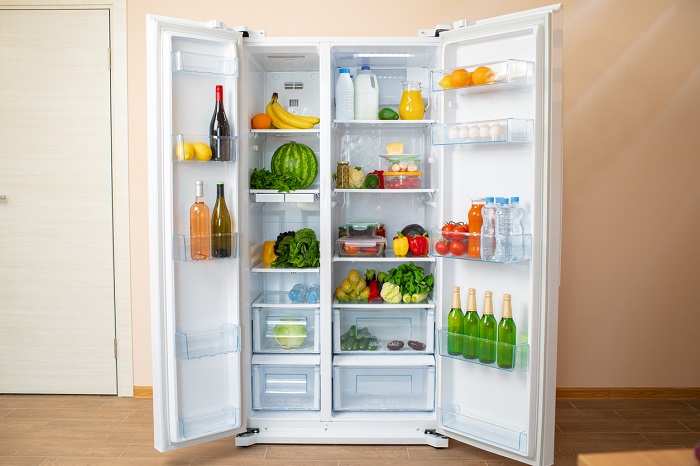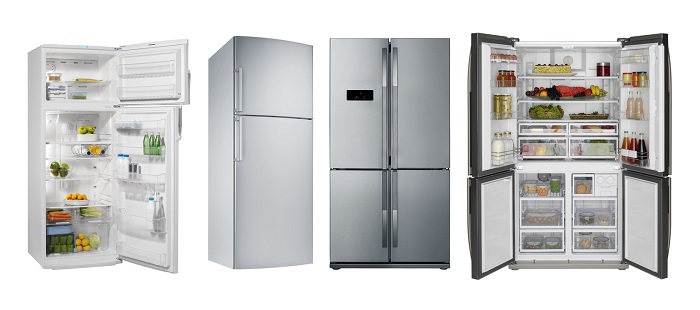
Imagine getting home from making a substantial purchase (like a new refrigerator), only to find out the unit won’t even make it through your front door ― let alone in your kitchen. For this specific reason and many other variables, it’s very important to know exactly what you’re getting into when investing in a new fridge. Refrigerators usually aren’t something that most of us buy very often. However, knowing what you need in terms of food storage and what will be the right style and fit for your home will put you in a great position when it comes time to make a purchase. To help make your decision as stressless as possible, our team of experts has put together a guide that breaks down everything you need to know about refrigerator sizes so that you can make the best choice for your own humble abode.
At a Glance:
What Refrigerator Size Do I Need?
Standard Refrigerator Sizes by Type
How to Measure for a New Refrigerator
What Refrigerator Size Do I Need?

Many of us have no idea where to start when trying to figure out refrigerator width sizes and the other dimensions that come along with this workhorse of a kitchen appliance. To help you determine the ideal storage capacity for your refrigerator, the size of your family (or roommates) is usually a great place to start. However, a refrigerator’s lifespan is around 13 years, so it’s also crucial to think ahead in the future to determine which size will work best for your home. Will your home have any additional residents? Do you like to host often? The answers to these essential questions very well could direct you towards a refrigerator with just the right amount of storage space.
To help you decide how much capacity and which configuration you may need, refer to this refrigerator sizes chart that breaks down which fridge sizes offer the ideal amount of storage space for your home’s needs:
|
Family Size |
Refrigerator Capacity |
Best Refrigerator Configurations | |
|
| |||
|
1 or 2 people |
4–13 cu. ft. |
Top-freezer refrigerators, bottom freezer refrigerators | |
|
3 or 4 people |
14–24 cu. ft. |
Top-freezer refrigerators, bottom freezer refrigerators, French door refrigerators, side-by-side refrigerators | |
|
5+ people |
25+ cu. ft. |
French door refrigerators, side-by-side refrigerators | |
Shop Our Refrigeration Catalog
Standard Refrigerator Sizes by Type

Along with the refrigerator’s overall capacity, it’s also vitally important to account for the fridge’s dimensions as they pertain to your kitchen’s arrangement. You might be thinking, “What is a standard size refrigerator?” So, to help make things as easy and transparent as possible, here are the average refrigerator sizes across the most popular configurations on the market.
French Door Refrigerator Sizes
Width: From 29-1/2 to 36 inches
Height: From 67 to 70-1/8 inches
Depth: From 29-3/8 to 34-5/8 inches
Side by Side Refrigerator Sizes
Width: From 32-3/4 to 39-3/4 inches
Height: From 65-7/8 to 71-1/4 inches
Depth: From 28-3/4 to 30-1/4 inches
Column Refrigerator Sizes
Width: From 18 to 36 inches
Height: From 83 ½ to 85 inches
Depth: Around 24 inches
Top Freezer Refrigerator Sizes
Width: From 28-3/4 to 32-3/4 inches
Height: 61-3/4 to 66-1/4 inches
Depth: Around 34-1/4 inches
Bottom Freezer Refrigerator Sizes
Width: From 29-1/2 inches to 32-3/4 inches
Height: From 67 to 70 inches
Depth: Around 33-3/8 inches
Counter Depth Refrigerator Sizes
Width: From 30 to 36 inches
Height: From 66 to 72 inches
Depth: Around 25 inches
Built In Refrigerator Sizes
Width: From 18 to 48 inches
Height: From 72 to 84 inches
Depth: Around 35 inches
How to Measure for a New Refrigerator

Step 1
Start off by measuring the width of your refrigerator space by the countertop, beneath any cabinets, and underneath the base of the cabinets as well. If your fridge is going to rest against a wall without any cabinets surrounding it, your choice of refrigerator width won’t be restricted.
Step 2
Next, measure the height of refrigerator space from the floor straight up to the lowest point under any cabinets (if applicable.) Generally speaking, a full size refrigerator needs at least one inch of overhead space for proper ventilation. The best way to account for this while measuring is by subtracting one inch from your recorded measurement.
Step 3
Last but certainly not least, once you record the height of the refrigerator and refrigerator width, you’ll need to measure the depth of your fridge space. Start from the back wall where you plan to place the fridge and then go towards the front edge of your cabinets by the neighboring wall. Since at least one inch of space is required between the back of the kitchen appliance and the wall for ventilation, just like recording the fridge height, subtract one inch from your measurement.
Extra Measuring Tips & Tricks
- If you’re considering a bottom freezer refrigerator or French-door model, ensure that the path of the freezer drawer has no obstructions when being opened.
- If you’re considering a French door fridge or side-by-side model, double-check that both doors clear any surrounding cabinets on each side and make a note of your body’s position relative to when the doors are open.
- If you’re considering a refrigerator small size or standard-depth unit, the height to the top of the fridge (rather than a hinge) is the most important height measurement because hinges are usually at the front of the appliance and rarely interfere with enclosures or cabinetry.
- If you’re considering a counter-depth model, contradictory to what we just said above, the hinge height should be the first aspect considered when measuring your space and making your refrigerator selection.
If you’re feeling lost or confused, don’t worry! Check out this quick video for a hands-on visual step-by-step guideline of how to measure for a new refrigerator:
Why Trust Idler’s Home?
At Idler’s Home, we believe in providing the highest quality products and service to our community. Over the span of 70 years (and counting), our business has seen successful growth, with over 100 employees and with five locations along the central coast of California. Not only do we offer major appliances, quality furniture, and the best mattresses but we also provide hot tubs and swim spas and perform kitchen design services. In addition, our trained professional installers can set up all appliances we sell while our factory-trained technicians service and repair them if they ever break down. Suffice it to say: Idler’s is dedicated to help you make the vision you have for your home a reality.
Shop Refrigerators at Idler’s
Envision the possibilities for your home and shop the best refrigerators at Idler’s. Our friendly team is always happy to help you with fridge sizes— whether you call us, email us, or use our online chat feature. Or better yet, stop by any of our five Central Coast locations to experience the quality of our products yourself. Visit us today!
Learn More: Tips To Increase Your Refrigerator's Efficiency